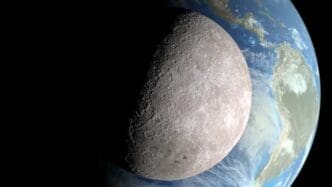NASA is actively studying the impact history of the Earth-Moon system, which serves as a vital historical record of our entire solar system.
The Moon’s surface holds an unrivaled record of the inner solar system’s impact events dating back to the formation of the Earth-Moon system. Unlike Earth, where geological processes like plate tectonics and erosion erase past events, the Moon’s lack of such activity allows it to preserve these ancient impacts. Consequently, studying the Moon’s impact history provides crucial insights into both the Earth-Moon system and the broader solar system’s history.
One of the key tools in this endeavor is the Lunar Reconnaissance Orbiter (LRO), which captured a stunning composite image of Earth from lunar orbit. This image, taken on October 12, 2015, near the lunar crater Compton, was created using high-resolution black-and-white and lower-resolution color images, offering a detailed view of Earth’s appearance from the Moon’s perspective.
Returning samples from the Moon’s South Pole-Aitken (SPA) Basin, located on the Moon’s far side, is another significant aspect of this research. By analyzing these samples, scientists can determine the basin’s age and refine the early Earth-Moon impact history timeline. Current data and crater statistics suggest that while the lunar impactor flux was relatively constant over the past 3 billion years, it was significantly higher in earlier periods.
The possibility of a ‘late heavy bombardment’ around 3.9 billion years ago, correlating with the emergence of life on Earth, is a topic of considerable interest. If confirmed, understanding this period’s impact history may shed light on how such events influenced life on our planet.
NASA’s exploration of the Earth-Moon impact history is pivotal in understanding not only the lunar past but also the broader dynamics of our solar system. This ongoing research promises to unravel mysteries about planetary formation and the evolution of life on Earth.
Source: Science.nasa
Source: Science.nasa







